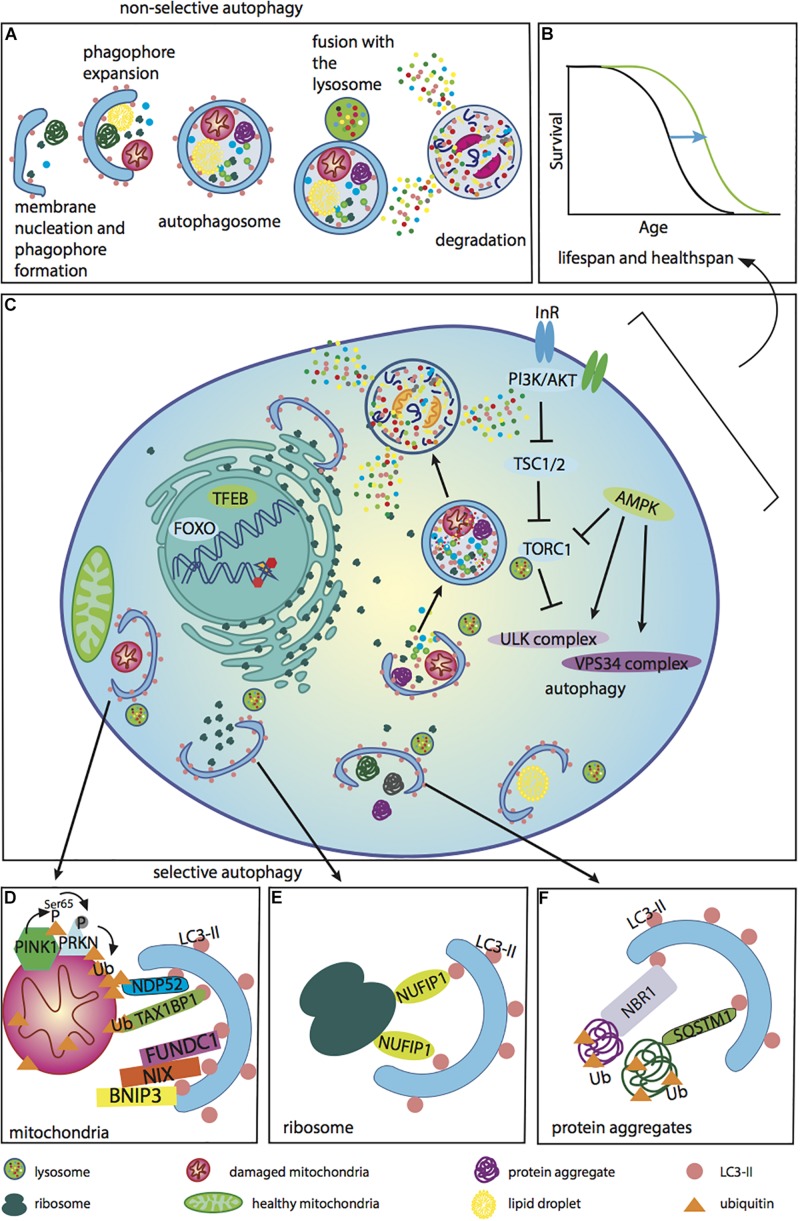FIGURE 1.
Autophagy regulators and functions associated with anti-aging effects. Different cellular components can be degraded by either non-selective or selective autophagy. These forms of autophagy are regulated by PI3K, mTOR, and AMPK, as well as the transcription factors TFEB and FOXO, which are accountable for the transcription of many genes involved in the autophagy process. (A) The different steps of non-selective autophagy. Upon autophagy initiation, a phagophore is formed and expanded, thereby producing an autophagosome. The matured phagosome fuses with the lysosome, initiating degradation of the autophagosome’s inner membrane. Cellular components captured within are subsequently degraded and released into the cytoplasm. Autophagy occurs under basal conditions in the cell, but can be up-regulated during stress. The autophagy process is inefficient during aging. (B) A lifespan curve illustrating the positive effects of enhancing autophagy during aging to improve the recycling of different cellular components, extending lifespan and healthspan. Anti-aging effects of autophagy up-regulation have been demonstrated in several model organisms. It has been shown in a number of studies that the lifespan of long-lived mutants is (reduced upon down-regulation of autophagy. In addition, there are a few critical studies showing that up-regulation of autophagy by overexpression of one of the autophagy genes extends lifespan. (C) An illustrative diagram demonstrating the negative regulation of autophagy by PI3K/AKT and mTORC1, and the positive modulation of autophagy by AMPK via effects on the autophagy complexes ULK and VPS34. Phagophore expansion leads to the engulfment of various cellular components, such as ribosomes, protein aggregates and lipids, via selective as well as non-selective autophagy. In addition, autophagy plays an important role in the DNA damage response and the nuclear-associated genes, TFEB and FOXO, play important roles in regulating autophagy. (D) Defective mitochondria are cleared by the cell through mitophagy. This is the process whereby damaged depolarized mitochondria can be degraded by the PINK1-Parkin pathway, which is ubiquitin-dependent. In cells with healthy mitochondria, PINK1 is continuously degraded, while Parkin is in the cytoplasm. Upon stress, PINK1 is stabilized on the outer mitochondrial membrane, where it phosphorylates ubiquitin and E3 ubiquitin ligase Parkin. Once Parkin is recruited to the mitochondria, it then ubiquitinates some of the outer membrane mitochondrial proteins. These polyubiquitin K63-linked chains are phosphorylated, creating a degradative signal for autophagy. Receptor proteins involved in this pathway include NDP52 and TAX1BP1. These proteins recognize phosphorylated polyubiquitin chains and link damaged mitochondria to LC3-II. Another mechanism for mitochondrial degradation involves receptor-mediated autophagy by BNIP3, NIX and FUNDC1. These receptors also interact with LC3 via the LIR domain and target depolarized mitochondria for degradation. For mitophagy to occur, damaged mitochondria must be separated by fission. Healthy mitochondria are essential for cellular ATP production and the maintenance of cellular energy homeostasis. (E) The ribophagy receptor NUFIP1 mediates degradation of ribosomes (Wyant et al., 2018). (F) Protein aggregates are ubiquitinated and degraded by autophagy with the help of the autophagy receptors NBR1 and SQSTM1.)

